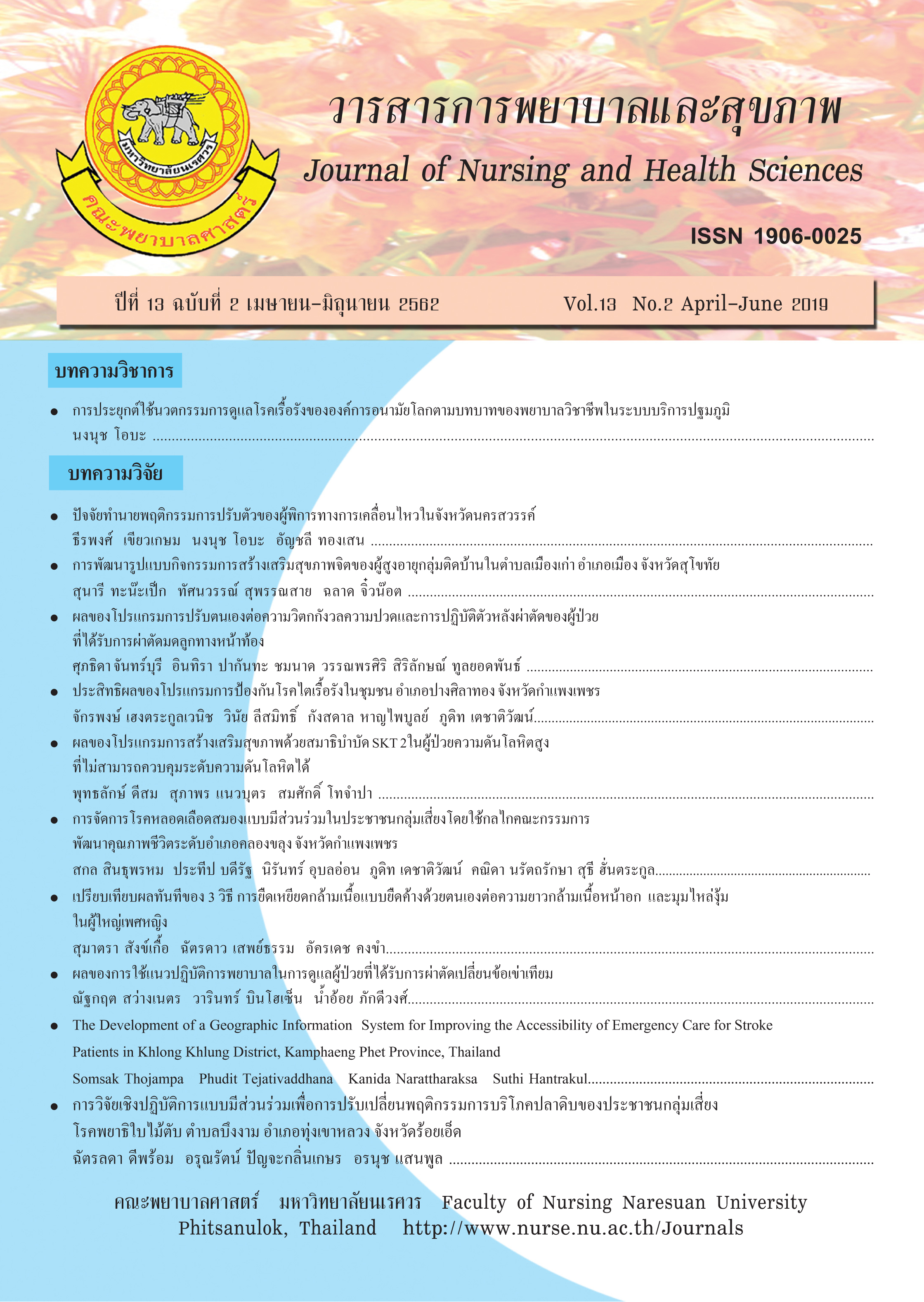Participatory Action Research in the Modification Consumption Behavior Raw Fish among Risk Persons of Opisthorchis Viverrini at Bueng Ngam Subdistrict, Thung Khao Luang District, Roi-Et Province
Main Article Content
Abstract
This Participatory Action Research aimed to 1) study the situation of raw fish consumption behavior 2) create a process to participate in the modification of raw fish consumption behavior and 3) study the effect of the participation process modification of raw fish consumption behavior in the community. The total sample were 88 cases, which was composed of the participatory action research group (n = 33) and the participants of the program which were the liver fluke disease risk group (n = 55). The instruments consisted of 2 parts: 1) the experimental instrument was the raw fish consumption behavior modification program. 2) questionnaires used to collect the data are the following : personal data, knowledge, attitude, self-efficacy, prevention behavior of raw fish consumption. The reliability of the questionnaires were knowledge questionnaire 0.86, attitude questionnaire 0.73, self-efficacy questionnaire 0.75, prevention behavior of raw fish consumption questionnaire 0.74.Descriptive statistics have been used in data analysis, such as percentage, mean, standard deviation, and paired t-test statistical significance at .05. The results showed that the people in the community still eat raw fish as a result of their occupation of sellingfish and traditional raw fish consumption which was the risk factors for the liver fluke and cholangiocarcinoma. After the meeting by using the AIC technique, the raw fish consumption behavior modification program was implemented and then the risk of 55 cases who participated in this program were collected. The program contained education activities,attitude building activities, strengthening activities, and self-efficacyof raw fishby applying the theory of Bandura.The statistics showed average score of knowledge, attitude, self-efficacy, and behavior of raw fish consumption that were significantly higher than beforethe program (p < .001) We suggestion that the modification program of raw fish consumption should be applied in similar communities.
Article Details
References
Bandura, A. (1997). Self-efficacy: the exercise of
control. New York: Freeman.
Best, J.W. (1977). Research education (3rded.).
Englewood Cliffs,New Jersey: Prentice Hall Inc.
Bloom, B. (1997). Handbook on formative and summative
evaluation of study of learning. New York: Mc
Graw-Hill.
Bloom, B. S., Madaus, G. F., & Hastings, J. T. (1997).
Evaluation to improve learning. New York:
McGraw-Hill.
Bueng Ngam Health Promoting Hospital. (2018). The result
of liver fluke examination and bile duct cance. Roi Et:
Bueng Ngam Health Promoting Hospital. [In Thai].
Chokdamrongsuk, J. (2018). Decades of liver fluke - bile
duct cancer Phase 2, 2018.Retrieved 20
September 2018 from https://www.hfocus.org/
content/2018/07/16010.[In Thai].
Cholangiocarcinoma Foundationthai of Thailand.
(2018). Statistics and incidence of disease 2018.
Wechvichakarn Building, Faculty of Medicine,
KhonKaen University. [In Thai].
DeeProm, C.,& Wongyai, N. (2017). The development
of health prevention behavior fluke parasite egg
detected in the liver in Tong Thani sub district,
Thawat Buri, Roi Et province. Rachawadeesarn,
, 13-26. [In Thai].
Duangsong, R. (2007). Pattern for changing the pattern
of liver fluke disease prevention Cholangiocarcinoma
by participation of people in Hua Hin
Subdistrict, Huai Mek District, Kalasin Province.
Khon Kaen: Faculty of Public Health,Khonkaen
University.[In Thai].
Kaewphitun, S. (2013). Development of liver fluke
databases for prevention and control in Surin
province.Rachawadeesarn, [In Thai].
Kemmis, S., McTaggart, R., & Retallick, J. (2004).
The action research planner.Karachi: Aga Khan
University, Institute for Educational Development.
Kongjionong, C. (2010). The effectiveness of the health
education program together with social support
by village health volunteers knowledge, awareness
Disease prevention and control behavior
Dengue fever of family health leaders Bueng
Krachap, Wichian Buri District Phetchaboon.
Master thesis(public Health), Naresuan University,
Phitsanulok. [In Thai].
Langsatan, P., & Duangsong,R. (2018). The results of
the health education program together with short
book media for Change behavior to prevent liver
fluke disease in the liver fluke disease risk group
-59 years, Selaphum District, Roi Et Province.
Retrieved 20September2018 from https://
www.tci-thaijo.org
Ministry of Public Health. (2017). Importance of liver
fluke and bile duct cancer in Thailand.Bangkok:
Department of Disease Control, Ministry of
PublicHealth. [In Thai].
Phromphanjai, T. (2018). Model development for
community-based prevention and control of
opisthorchiasis in acommunity of Lahan
sub-district, Chatturat, Chaiyaphum, The Office
of Disease Prevention and Control 9th Nakhon
Ratchasima Journal, 24(1), 43-53. [In Thai].
Rungreangchai, G. (2018). Liver fluke disease risk
factors for bile duct cancer. Retrieved 24
September 2018 from https://www.hfocus.org/
content/2018/07/16010.
Roi-Et Provincial Provincial Public Health, (2018).
Primary prevention report in OV. Retrieved 10
September 2018 from https://cloud.cascap.in.th/
project84/report-y61
Wisetsang, W. (2017). Behavior modification program
by family health leaders to reduce the occurrence
of liver fluke disease in the labor group Khayung
Subdistrict, Uthumphon Phisai District Srisaket
Province. Nursing Journal, 4, 115-126.


